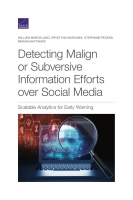by William Marcellino, Krystyna Marcinek, Stephanie Pezard, Miriam Matthews
 What evidence currently exists regarding malign or subversive information campaigns on social media?
What evidence currently exists regarding malign or subversive information campaigns on social media?
What analytic methods can be used to detect such campaigns on social media?
How could such methods be of use to the U.S. government, other researchers, and social media companies in the future?
The United States has a capability gap in detecting malign or subversive information campaigns before these campaigns substantially influence the attitudes and behaviors of large audiences. Although there is ongoing research into detecting parts of such campaigns (e.g., compromised accounts and "fake news" stories), this report addresses a novel method to detect whole efforts. The authors adapted an existing social media analysis method, combining network analysis and text analysis to map, visualize, and understand the communities interacting on social media. As a case study, they examined whether Russia and its agents might have used Russia's hosting of the 2018 World Cup as a launching point for malign and subversive information efforts. The authors analyzed approximately 69 million tweets, in three languages, about the World Cup in the month before and the month after the event, and they identified what appear to be two distinct Russian information efforts, one aimed at Russian-speaking and one at French-speaking audiences. Notably, the latter specifically targeted the populist gilets jaunes (yellow vests) movement; detecting this effort months before it made headlines illustrates the value of this method. To help others use and develop the method, the authors detail the specifics of their analysis and share lessons learned. Outside entities should be able to replicate the analysis in new contexts with new data sets. Given the importance of detecting malign information efforts on social media, it is hoped that the U.S. government can efficiently and quickly implement this or a similar method.
Key Findings
There were two distinct Russian information campaigns, one in Russian and one in French
Russian-language efforts were characterized with relatively high confidence as likely including state-sponsored actions; these efforts were focused within two communities.
French-language efforts were also focused within two communities; one of these was rated with high confidence, and the other with low confidence, as state-sponsored.
Although these information efforts cannot be linked directly to Russia, it is likely that the information campaigns detected as deliberate were indeed conducted by Russia.
There are challenges in detecting malign and subversive information efforts
There is a serious technical gap in current research into detecting information efforts: Current research is focused on detecting individual elements, not wholes at the level of aggregates.
For the foreseeable future, it is unlikely that a purely machine-based approach will have the kind of human-like precision with language data needed to robustly detect malign information efforts. This report outlines a human-in-the-loop approach that leverages what computers and humans do best, but data-ingestion expertise is required, and the overall process is expert-driven.
Recommendations
Given the urgency of the need to detect malign and subversive information efforts, and given the promise of this proof-of-concept study, the United States, allies, and partners should strongly consider operationalizing this method and complementary methods and technology.
Any U.S. government–led efforts to develop information efforts, detection methods, and technology should address the current research gap. Research should be focused on wholes at the level of aggregates, not on detecting individual elements.
The U.S. government should invest in developing professional expertise to appropriately support early detection of malign information efforts. Such professional expertise would include data science, social network analysis, text analytics, and culture/language expertise for select target audiences.
No comments:
Post a Comment